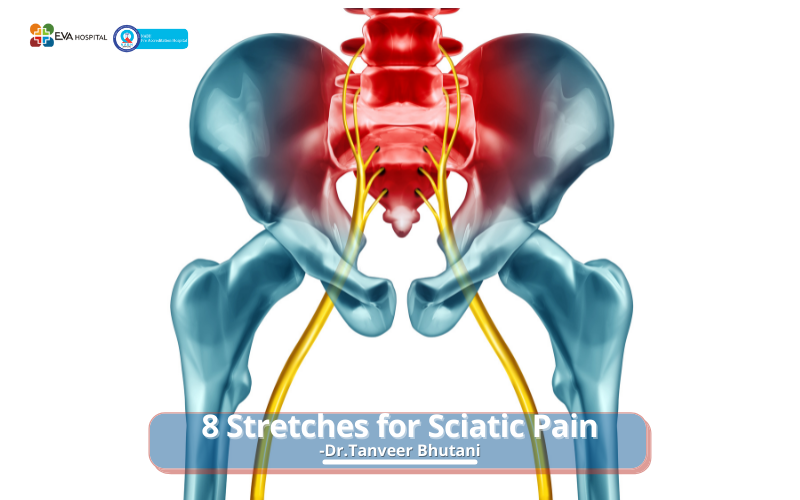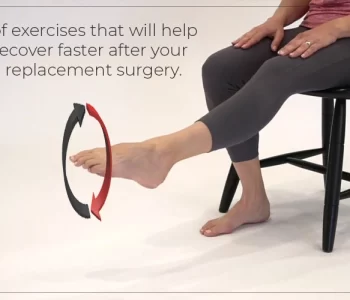8 Stretches for Sciatic Pain
 Eva Hospital
Eva Hospital
8 Stretches for Sciatic Pain
What is the Sciatic Nerve?
Sciatica refers to the pain that travels along the path of the sciatic nerve. Branching from the lower back, this nerve travels through the hips and buttocks and down each leg. Usually, sciatica pain affects only one side of the body.
Sciatica pain usually occurs when a herniated disk, bone spur on the spine, or narrowing of the spine compresses part of the nerve, causing inflammation, pain & some numbness in the leg.
The pain can be so severe and excruciating that the person does not even want to get off the bed. The most troublesome body parts usually are the lower back & hips.
Dr. Tanveer Bhutani at Eva Hospital says that “One of the best ways to relieve most sciatica pain is to do any stretch that can aid the external rotation of the hip to provide some relief.”
Relieving Sciatica Nerve Pain with Exercises and Stretches.
An irritated sciatic nerve can send burning, stinging, or shooting pains through your buttock and down the affected leg. Ask your doctor about various pain relief methods, as well as physical therapy.
Some exercises and stretches at home can help strengthen weak postural muscles and relieve pressure on the sciatic nerve to significantly reduce the pain.
Exercise helps to relieve sciatica due to the following tissue changes:
- Increased muscle strength.
- Improved bone health.
- Enhanced blood flow.
- Nourished spinal discs.
- Reduced stiffness of the sciatic nerve.
Always consult a doctor or physical therapist before trying these exercises.
Stretches that can help relieve Sciatica Pain
1. Lying Glute Stretch

This stretch helps in lengthening the piriformis muscle and relieves the pressure on the sciatic nerve.
Lying flat on your back, raise one foot and bring it to the opposite knee. Rest the ankle on the thigh. Grasp the bottom thigh with your hands and gently pull it towards your head.
Keep your spine pressed against the floor. Hold for at least 30 seconds while breathing deeply, then repeat on the other side. Perform this stretch many times.
2. Half Lord of the Fishes Yoga Pose
 This stretch can help relieve pain in the buttocks.
This stretch can help relieve pain in the buttocks.
Sit on a mat with your legs stretched in front of you and your hands flat on the mat just behind your hips. Bending your left leg, bring the heel up near the opposite buttock.
Crossing the right leg over the left leg, bring the foot outside the left thigh. Rotating your trunk to the right, rest your left upper arm against the right thigh. Press your trunk to the right gently and hold for 15-20 seconds. Repeat on the other side.
3. Sciatic Stretch
 This stretch enhances flexibility in the muscles surrounding the sciatic nerve.
This stretch enhances flexibility in the muscles surrounding the sciatic nerve.
Lying on your back with both knees bent so that the knees point upward and the feet are flat on the floor. Keep your back flat on the floor.
Bring one knee toward your chest, then grasp your thigh with both hands, keeping your foot flat and gently pushing your heel toward the sky. Hold for up to 30 seconds or as long as comfortable. Repeat on the other side. Perform several sets.
4. Prone Leg Raise
 This exercise helps to enhance the lower back strength.
This exercise helps to enhance the lower back strength.
Lying flat on your stomach with your arms at your sides and palms up, keep your head slightly raised, in a straight alignment from your spine. Don’t fold your chin.
Keeping your legs straight, raise one foot a few inches off the mat. Hold as long as possible. Repeat on the other side.
5. Pelvic Tilt
 This exercise helps in strengthening the lower back, glutes, and lower abdominal muscles.
This exercise helps in strengthening the lower back, glutes, and lower abdominal muscles.
Lying flat on your back on a mat, with the legs bent and the arms at the sides. Tighten the stomach muscles, flattening the back into the floor.
Tilting the hips and pelvis slightly upward, hold the position, while exhaling for 5 to 10 seconds. Release the position and relax for a few seconds, and repeat. Aim for 10 or more repetitions in starting increasing gradually.
6. Extension Exercise
 This exercise can be beneficial for sciatica pain originating in the lower spine.
This exercise can be beneficial for sciatica pain originating in the lower spine.
Lying on your stomach with your elbows bent at your sides and your hands extended, palms down, pull in your stomach.
Raise your chest slowly upwards by pressing down on your forearms and elbows. Elevate as high as you can and hold for a few seconds while breathing. Do 5 to 10 repetitions.
Performing this exercise many times each day brings the best results.
7. Knee-to-Chest Stretch
 This stretch helps to relax the lower back & leg muscles to reduce pressure on the sciatic nerve.
This stretch helps to relax the lower back & leg muscles to reduce pressure on the sciatic nerve.
Lie flat on your back on a mat. Bending both knees, slowly bring one knee toward your chest, then clasp your knee with both hands and gently pull toward you.
Hold for 10 seconds while breathing deeply. Repeat 10 times on each side. After this try bringing both knees toward the chest and holding them for a few seconds. Repeat five times.
8. Warrior Pose
 This yoga pose helps to enhance flexibility in the lower back & thighs.
This yoga pose helps to enhance flexibility in the lower back & thighs.
Standing on a mat with feet shoulder wide shoulder-width your left foot slightly outward, then step forward with your right foot.
Step forward as far out as you can while keeping the right knee aligned directly over your ankle, just as the way you perform a standing lunge.
Tilting your head back, raise your arms to the sky, above your chest, bringing the palms together. Hold for 30 seconds while inhaling and exhaling deeply. Repeat on the other side.
Bottom line
Sciatic Nerve pain is a situation that can be very distressing. But exercise and stretches can work wonders in relieving you of the pain.
https://youtu.be/m1lJaa1tMyE
Book a consultation with Dr. Tanveer Bhutani, a highly competent orthopedic doctor. He can help you to understand how these stretches can help and whether you should perform them.









